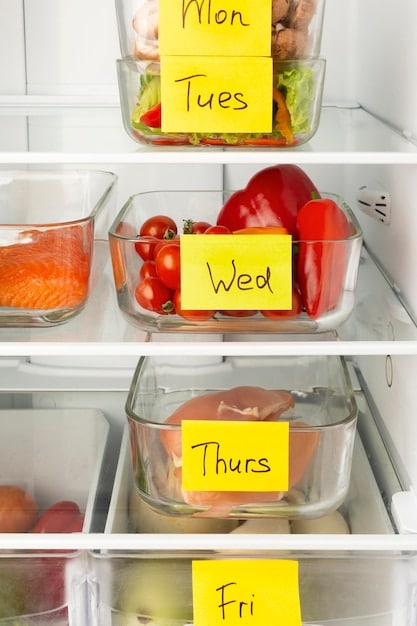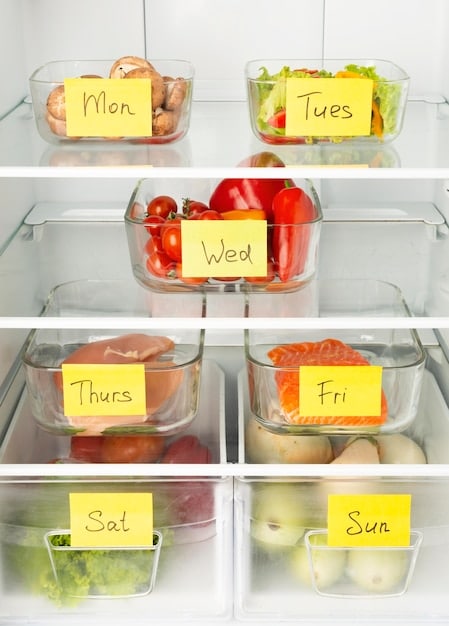Decoding Expiration Dates: Your Guide to Saving Money and Staying Safe

Understanding expiration dates is crucial for both food safety and saving money, as these dates often indicate quality rather than safety, leading to unnecessary food waste and increased grocery bills.
Navigating the world of expiration dates can feel like deciphering a secret code. What do those dates really mean for food safety, and how can understanding them help you save money? The truth about expiration dates: how to save money by understanding food safety guidelines is simpler than you might think.
The Confusing World of Food Labeling
Food labels are designed to inform consumers, but the variety of terms used can often lead to confusion. Understanding these terms is the first step in making informed decisions about food safety and waste.
Decoding “Sell By,” “Use By,” and “Best By”
Different phrases on food labels have different meanings, but they are often misinterpreted as strict safety deadlines. Recognizing these distinctions can significantly reduce unnecessary food waste.
- “Sell By” Date: This tells the store how long to display the product for sale. You should buy the product before the date expires.
- “Use By” Date: This is the manufacturer’s suggestion for when the product will be at peak quality.
- “Best By” Date: Similar to “use by,” this indicates when the product will have the best flavor or quality.
These dates are primarily about quality and taste, not safety. Food can often be safely consumed after these dates if stored properly.

The Real Meaning Behind Expiration Dates
Expiration dates are often misunderstood, leading to unnecessary food waste. It’s important to differentiate between food safety and food quality when interpreting these dates.
Food Safety vs. Food Quality
Food safety refers to whether a food is safe to eat and won’t cause illness. Food quality, on the other hand, refers to the food’s taste, texture, and appearance.
How Manufacturers Determine Dates
Manufacturers conduct tests to determine how long a product will maintain its peak quality. These tests consider factors like taste, texture, appearance, and nutritional value.
By understanding the distinctions between food safety and quality, and how manufacturers determine these dates, consumers can make smarter choices about when to discard food.
How to Properly Store Food to Extend Its Life
Proper food storage is crucial for extending the life of your groceries and ensuring food safety. Implementing effective storage techniques can help you save money and reduce waste.
Refrigerator Storage Tips
Organizing your refrigerator correctly and maintaining the right temperature are key to keeping your food fresh for longer. Knowing where to store specific items can make a big difference.
- Temperature Control: Keep your refrigerator at or below 40°F (4°C).
- Proper Placement: Store dairy and meats on the lower shelves where it’s coldest.
- Crisper Drawers: Use crisper drawers for fruits and vegetables to maintain humidity.
Freezer Storage Tips
Freezing food is an excellent way to preserve it for long periods. However, proper techniques are essential to maintain quality and prevent freezer burn.
- Wrap Tightly: Use airtight containers or freezer bags to prevent freezer burn.
- Label and Date: Always label and date your frozen items to keep track of how long they’ve been stored.
- Freeze Quickly: Freeze food as quickly as possible to minimize ice crystal formation.

Foods That Last Longer Than You Think
Some foods have a surprisingly long shelf life if stored correctly. Knowing which foods can last longer can significantly reduce your grocery bills.
Pantry Staples with Extended Shelf Lives
Certain pantry staples can last for months or even years beyond their expiration dates if stored properly. These items are great to stock up on to save money.
- Honey: Can last indefinitely due to its low moisture content and acidity.
- Dried Beans: Can last for years if stored in a cool, dry place.
- White Rice: Can also last for years when stored properly, but brown rice has a shorter shelf life due to its natural oils.
Refrigerated Foods with Surprising Longevity
Some refrigerated foods can also last longer than their expiration dates suggest, provided they are stored properly and show no signs of spoilage.
By understanding which foods have extended shelf lives, you can reduce food waste and save money on your grocery bills.
How to Check for Spoilage Before Discarding Food
Learning to identify signs of spoilage in different types of food is crucial for making informed decisions about whether to discard them. Relying solely on expiration dates can lead to unnecessary waste.
Recognizing Signs of Spoilage in Common Foods
Each type of food has different indicators of spoilage. Knowing what to look for can help you determine if a food is still safe to eat, regardless of the date on the label.
For dairy products, sour smells, discoloration, and a lumpy texture are key signs of spoilage. With meats, look for changes in color, texture, and any foul odors.
When to Throw It Out, No Questions Asked
While it’s important to avoid unnecessary waste, there are situations where food should be discarded immediately to avoid the risk of foodborne illness.
If you notice mold, a strong foul odor, or any unusual texture or discoloration, the food should be discarded. When in doubt, it’s always best to err on the side of caution to protect your health.
Practical Tips for Reducing Food Waste and Saving Money
Reducing food waste is not only good for the environment, but it can also significantly reduce your grocery bills. Implementing practical strategies can help you make the most of your food purchases.
Meal Planning and Smart Shopping
Planning your meals ahead of time and shopping with a list can help you avoid impulse purchases and ensure you only buy what you need.
- Plan Your Meals: Create a meal plan for the week to use up ingredients you already have.
- Shop with a List: Stick to your list to avoid buying unnecessary items.
- Check Your Inventory: Before shopping, take stock of what you already have in your pantry and refrigerator.
Creative Ways to Use Leftovers
Transforming leftovers into new meals is a great way to reduce food waste. With a little creativity, you can create delicious and nutritious meals from ingredients you already have on hand.
- Soup and Stews: Turn leftover vegetables and meats into hearty soups and stews.
- Casseroles: Use leftover pasta, rice, and vegetables in casseroles.
- Frittatas and Quiches: Incorporate leftover meats and vegetables into frittatas and quiches.
By implementing these practical tips, you can reduce food waste, save money, and make the most of your grocery purchases. Small changes in your shopping and cooking habits can have a big impact.
| Key Point | Brief Description |
|---|---|
| 🗓️ Understand Date Labels | “Sell By,” “Use By,” and “Best By” dates mainly indicate quality, not safety. |
| 🧊 Proper Storage | Store food correctly in the refrigerator and freezer to extend its shelf life. |
| 👀 Check for Spoilage | Look for signs like color changes, foul odors, and unusual textures before discarding food. |
| 📝 Meal Planning | Plan meals and shop with a list to avoid unnecessary purchases and reduce waste. |
Frequently Asked Questions
▼
“Sell by” dates are for retailers, indicating when to remove the product from shelves. “Use by” dates suggest when the product will be at its best quality.
▼
Often, yes. Expiration dates are mainly about quality, not safety. Check for spoilage signs and use your judgment. If it looks, smells, and tastes okay, it’s likely safe.
▼
Proper storage significantly extends shelf life by slowing down spoilage. Keep perishables refrigerated and use airtight containers to prevent freezer burn.
▼
Look for changes in color, texture, and odor. Sour smells in dairy, slimy texture in meat, and mold growth are clear indicators of spoilage.
▼
Meal planning helps you buy only what you need, use ingredients efficiently, and minimize leftovers. This reduces waste and saves money on groceries.
Conclusion
Understanding the truth about expiration dates can transform how you shop, store, and consume food. By focusing on food safety guidelines and quality indicators rather than blindly following dates, you can reduce waste, save money, and make more informed decisions about the food you eat.





